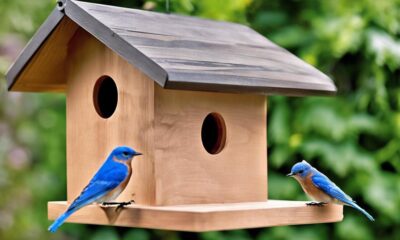Christmas Decoration
Why Do We Put up Decorations at Christmas
2025
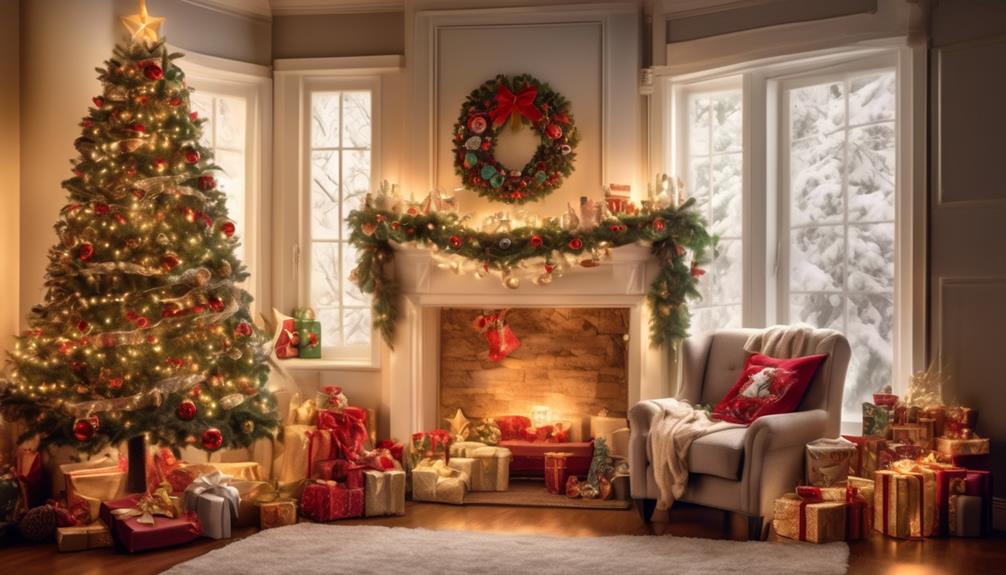
In the holiday season, it’s impossible to resist the joy of decorating our homes with sparkling lights, vibrant ornaments, and the aromatic scent of evergreen trees.
But have you ever wondered why we go to such lengths to decorate for Christmas? The origins of this tradition date back centuries, and the symbolism behind each decoration holds deep meaning.
Over time, our decorating traditions have evolved, influenced by both religious practices and cultural customs. While some may argue that commercialization has played a role in the abundance of decorations, there is no denying the joy and warmth they bring to our homes and hearts.
Join us as we explore the reasons behind why we put up decorations at Christmas and discover the personal connections we have to these festive adornments.
Key Takeaways
- Christmas decorations have ancient origins and are deeply rooted in symbolism and religious traditions.
- Evergreen plants, wreaths, and nativity scenes symbolize eternal life, renewal, and the birth of Jesus Christ.
- Different cultures infuse their own meanings into decorations, adding diversity and richness to the holiday.
- Christmas decorations have a psychological impact, evoking happiness, nostalgia, and a sense of community and tradition.
Origins of Christmas Decorations
The origins of Christmas decorations can be traced back to ancient civilizations. In these societies, the use of evergreen plants and festive ornaments played a significant role in celebrating the winter solstice. Symbolism in holiday decor has always been important, as it helps to convey the cultural traditions and beliefs of a particular society.
In ancient Rome, wreaths made of evergreen branches were hung on doors as a symbol of victory and renewal. The Romans also decorated their homes with candles and greenery during the festival of Saturnalia, which marked the winter solstice. Similarly, in ancient Egypt, palm branches were brought into homes to celebrate the winter solstice and the return of the sun.
As Christianity spread throughout Europe, these pagan traditions were incorporated into the celebration of Christmas. The use of evergreens, such as fir trees, became associated with the birth of Christ and the promise of eternal life. The tradition of decorating trees with ornaments and lights also originated during this time.
In Germany, for instance, people would hang apples and other fruits on their trees to symbolize the Garden of Eden. Over time, these decorations evolved into the colorful baubles and ornaments that we see today.
Symbolism of Christmas Decorations
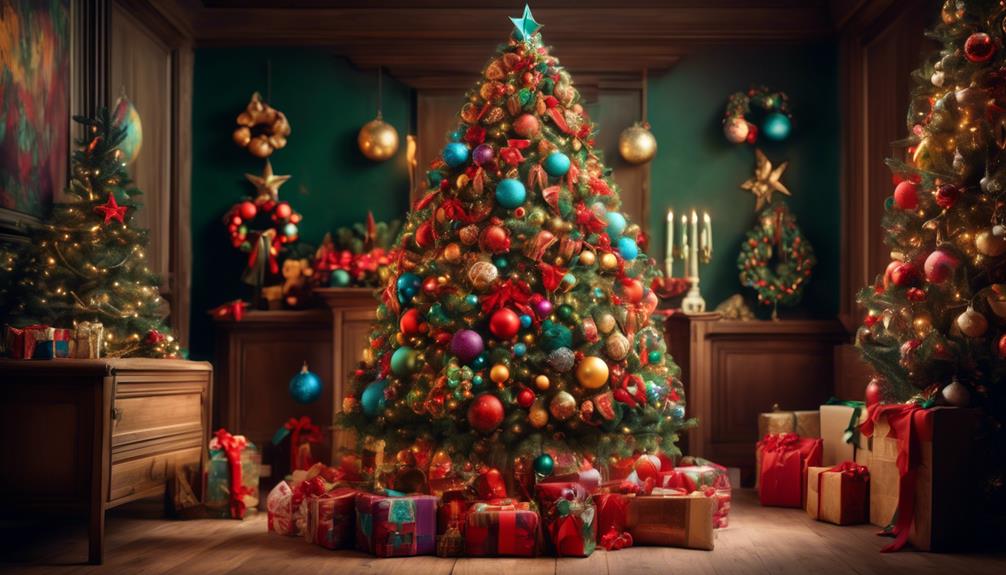
After exploring the origins of Christmas decorations and their incorporation into the celebration of Christmas, it is fascinating to delve into the symbolism behind these festive adornments. Christmas decorations have deep-rooted symbolism that varies across cultures and regions, reflecting the diverse cultural influences on festive decor.
| Christmas Decoration | Symbolism |
|---|---|
| Christmas Tree | Evergreen tree symbolizes eternal life and rebirth. It represents the hope of new beginnings and the everlasting love of God. |
| Wreaths | Circular shape symbolizes eternity and everlasting life. It represents the unending love and grace of God. The addition of holly or berries represents the blood of Christ. |
| Nativity Scene | Depicts the birth of Jesus Christ, reminding Christians of the central event in their faith. It symbolizes hope, salvation, and the promise of eternal life. |
These are just a few examples of the symbolism in holiday decor. The cultural influences on festive decor are vast and diverse, with each culture infusing its own meanings into the decorations. For example, in some cultures, the color red symbolizes luck and joy, while in others, it represents the blood of Christ. Similarly, the use of lights symbolizes the triumph of light over darkness and the presence of Christ as the light of the world.
Understanding the symbolism behind Christmas decorations adds depth and meaning to the festive season. It allows us to appreciate the rich history and cultural significance of these adornments, reminding us of the true spirit of Christmas.
Evolution of Christmas Decorating Traditions
As we explore the evolution of Christmas decorating traditions, it's important to understand the historical origins of these practices. From ancient pagan rituals to religious symbolism, the act of adorning our homes during the holiday season has deep roots that have evolved over time.
Additionally, examining the symbolism in festive decor allows us to understand the deeper meanings behind the ornaments and decorations we use today.
Historical Origins of Decorations
Through the centuries, the evolution of Christmas decorating traditions has witnessed a myriad of historical origins that have shaped the way we adorn our homes during the holiday season. These decorations hold a significant historical significance, reflecting cultural influences from different time periods and regions.
- Evergreen Trees: The practice of bringing evergreen trees into homes during winter can be traced back to ancient pagan traditions. These trees symbolized life and fertility during the harsh winter months.
- Candlelight: Candles were used to decorate Christmas trees before the invention of electric lights. This tradition originated in Germany in the 17th century and symbolized the light of Christ.
- Holly and Ivy: The use of holly and ivy in Christmas decorations dates back to Roman times. These plants were associated with winter solstice celebrations and were believed to ward off evil spirits.
Each of these historical origins has contributed to the rich tapestry of Christmas decorating traditions we enjoy today.
Symbolism in Festive Decor
Throughout history, the evolution of Christmas decorating traditions has been marked by a deep symbolism that reflects the cultural and religious significance of the holiday season. From the earliest days of celebrating Christmas, people have adorned their homes with festive decor that carries meaning beyond mere decoration. These symbols serve as a visual representation of the beliefs, values, and traditions associated with the holiday.
One of the most recognizable symbols of Christmas is the Christmas tree. Its evergreen nature represents eternal life, while the act of decorating it symbolizes the joy and celebration of the season. The use of lights on the tree also holds significance, representing the light of Christ and the hope it brings.
Another symbol that holds cultural significance is the wreath. Its circular shape represents eternity and the never-ending love of God. The use of holly, with its vibrant red berries, symbolizes the blood of Christ and his sacrifice.
Table: Symbolism in Festive Decor
| Symbol | Meaning |
|---|---|
| Christmas Tree | Eternal life, joy, and celebration |
| Lights | Light of Christ and hope |
| Wreath | Eternity and the love of God |
| Holly | Blood of Christ and sacrifice |
These symbols and their meanings have been passed down through generations, contributing to the rich tapestry of Christmas traditions. They serve as a reminder of the cultural and religious significance of the holiday season, connecting people to their heritage and fostering a sense of unity and joy. As we continue to celebrate Christmas, let us embrace and appreciate the symbolism in our festive decor, understanding its deeper meaning and the cultural legacy it represents.
Modern Decorating Trends
After exploring the deep symbolism behind traditional Christmas decorations, it's fascinating to examine how these symbolic elements have evolved over time, giving rise to modern decorating trends that capture the spirit of the holiday season.
In today's world, modern design has made its mark on Christmas décor, with a shift towards a more minimalist style. This approach embraces simplicity, clean lines, and a focus on functionality.
Some key elements of modern Christmas decorating trends include:
- Use of natural materials: Instead of the traditional plastic and synthetic materials, modern design incorporates more natural elements such as wood, glass, and metal.
- Monochromatic color schemes: A minimalist style often embraces a limited color palette, with a preference for neutral tones and simple, understated decorations.
- Streamlined and geometric shapes: Modern design favors clean and geometric shapes, moving away from the ornate and intricate designs of the past.
These modern decorating trends reflect a desire for simplicity and a departure from the excesses of traditional Christmas decorations. By embracing a more minimalist style, individuals can create a contemporary and elegant holiday atmosphere.
Religious Significance of Christmas Decorations
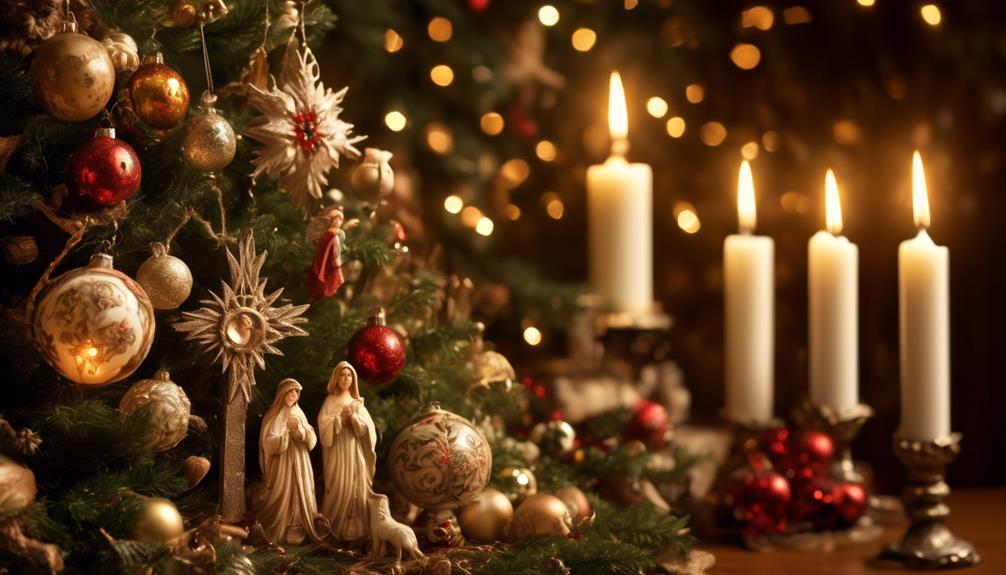
One cannot fully grasp the religious significance of Christmas decorations without delving into their intricate history and symbolism. The use of decorations during Christmas has deep roots in religious symbolism and has been influenced by various cultural traditions throughout history. Evergreens, for example, have long represented eternal life, a theme central to the Christian faith, while candles symbolize the light of Christ in a dark world. Mexican Christmas decoration traditions add a vibrant dimension to this tapestry, with elements like bright poinsettias, nativity scenes (known as “nacimientos”), and intricately crafted papel picado banners that reflect both faith and festive celebration. These traditions showcase how global cultures have uniquely integrated their customs into the broader religious and spiritual meanings of Christmas.
| Symbol | Meaning |
|---|---|
| Evergreen Trees | Represents eternal life and the promise of Christ |
| Wreaths | Signifies the eternal love of God |
| Angels | Represents the messengers of God |
The use of evergreen trees as Christmas decorations dates back to ancient times when they were seen as symbols of eternal life. In Christianity, the evergreen tree is a reminder of the promise of Christ, who offers eternal life to believers. Wreaths, often made from evergreen branches, are circular in shape, symbolizing eternity and the eternal love of God.
Angels are another common Christmas decoration that holds religious significance. In Christianity, angels are seen as messengers of God and are believed to have played a significant role in the story of Jesus' birth. The presence of angels in Christmas decorations serves as a reminder of the divine message of peace and joy brought by the birth of Jesus.
Throughout history, various cultural influences have shaped the way Christmas decorations are used and displayed. From the German tradition of decorating Christmas trees to the English custom of hanging wreaths on doors, different cultures have added their unique touches to the religious symbolism of Christmas decorations.
Cultural Influences on Christmas Decorations
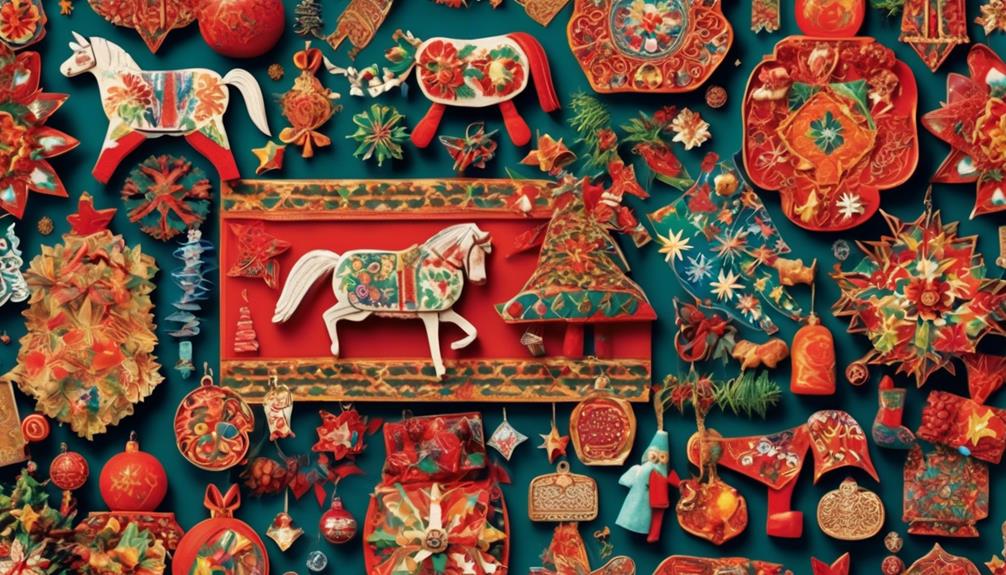
The cultural influences on Christmas decorations have played a significant role in shaping the way they're used and displayed throughout history. These influences vary across different regions and time periods, but they all contribute to the rich tapestry of Christmas traditions we've today.
- Religious Traditions: Christianity has had a profound impact on the way Christmas is celebrated and decorated. Nativity scenes, angels, and crosses are all common motifs that reflect the religious significance of the holiday.
- Folklore and Mythology: Cultural legends and stories have also influenced Christmas decorations. In some regions, mythical figures like Santa Claus or the Yule Goat are central to the holiday and are depicted in ornaments and other decorations.
- Seasonal Symbolism: The cultural association of certain colors, plants, and objects with the winter season has also influenced Christmas decorations. Evergreen trees, holly, mistletoe, and the colors red and green are all symbols of winter and rebirth that have been incorporated into Christmas decor.
These cultural influences not only shape the physical appearance of Christmas decorations but also have a psychological impact on those who participate in the holiday festivities. They evoke a sense of tradition, nostalgia, and belonging, allowing people to connect with their cultural heritage and create meaningful experiences during this special time of year.
Psychological Impact of Christmas Decorations
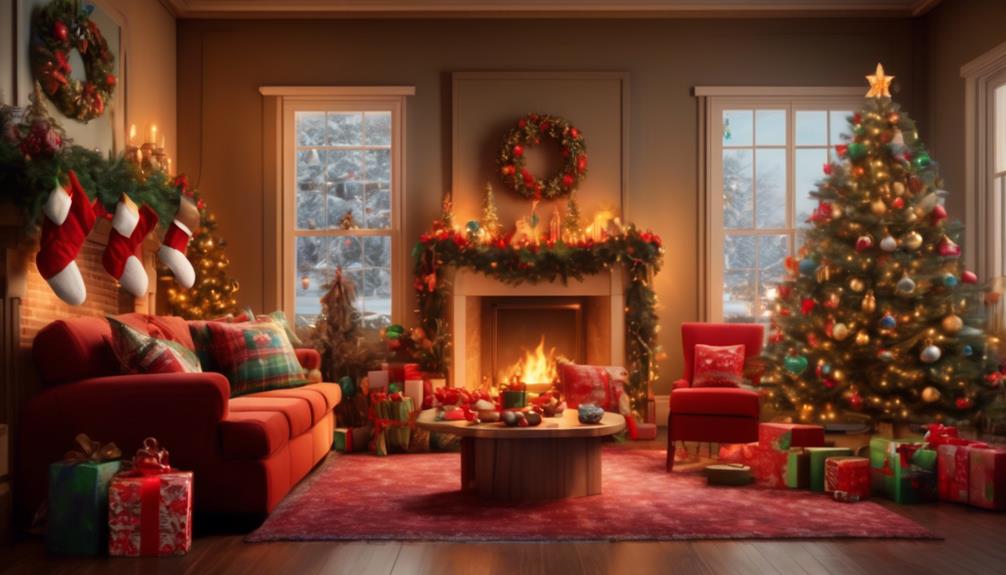
When it comes to Christmas decorations, there's a strong emotional connection that many of us feel. From the ornaments passed down through generations to the handmade crafts created with love, these decorations hold memories and symbolize the joy and warmth of the season.
Beyond the sentimental value, the act of decorating and creating a festive atmosphere can have a profound impact on our mood and well-being. The colors, lights, and festive elements can evoke feelings of happiness, nostalgia, and excitement, making us feel more connected to the holiday spirit.
Emotional Connection to Decorations
As we delve into the psychological impact of Christmas decorations, it becomes evident that these festive adornments evoke a myriad of emotions and hold significant historical and cultural significance.
The emotional attachment we feel towards these decorations stems from the sentimental value they hold. They serve as tangible reminders of cherished memories and traditions, connecting us to our past and those we hold dear. Whether it's the handmade ornaments passed down through generations or the twinkling lights that bring a sense of warmth and joy, these decorations have the power to evoke feelings of nostalgia, happiness, and comfort.
They create a sense of belonging and foster a strong sense of community, as they're often displayed for all to see. In this way, Christmas decorations not only enhance the holiday spirit, but also play a vital role in our emotional well-being during the festive season.
- Decorations serve as tangible reminders of cherished memories and traditions.
- They evoke feelings of nostalgia, happiness, and comfort.
- Christmas decorations foster a strong sense of community and belonging.
Creating a Festive Atmosphere
Creating a festive atmosphere during the Christmas season involves strategically placing decorations that evoke a sense of joy, nostalgia, and anticipation, enhancing the overall psychological impact of the holiday.
The act of adorning our homes with twinkling lights, sparkling ornaments, and fragrant evergreen wreaths serves a deeper purpose than mere aesthetics. The holiday spirit isn't simply conjured by the physical presence of decorations; it's the emotional response they elicit within us that truly brings forth the joy and merriment of the season.
When we see familiar symbols like Santa Claus, reindeer, and snowflakes, our brains automatically associate them with happy memories and positive emotions. These decorations act as triggers, evoking a sense of childlike wonder and excitement, creating joy and fostering a sense of togetherness.
The carefully curated placement of Christmas decorations plays a vital role in cultivating an atmosphere that's both festive and harmonious, allowing us to fully immerse ourselves in the magic of the holiday season.
Impact on Mood and Well-Being
The placement and arrangement of Christmas decorations have a profound psychological impact, influencing our mood and well-being during the holiday season. The festive colors, twinkling lights, and cheerful ornaments create a joyful atmosphere that can significantly impact our mental health.
Here are three ways in which Christmas decorations affect our mood and well-being:
- Boosting our mood: The sight of beautifully decorated Christmas trees and festive ornaments can instantly uplift our spirits and bring a sense of joy and happiness. This positive mood can have a ripple effect on our overall well-being, enhancing our productivity and motivation.
- Providing a sense of comfort: Christmas decorations often evoke feelings of nostalgia and warmth, reminding us of cherished memories and traditions. This sense of familiarity and comfort can help reduce stress and anxiety, promoting better mental health.
- Fostering a sense of community: Christmas decorations not only create a festive atmosphere in our own homes but also in our neighborhoods and communities. The sight of well-decorated streets and houses can foster a sense of togetherness and connection, promoting social interactions and enhancing our overall well-being.
Role of Commercialization in Christmas Decorating

Commercialization plays a significant role in shaping the way Christmas decorations are perceived and utilized. The impact of commercialization on Christmas decorating can't be overstated. Over the years, the influence of consumerism has transformed the way we decorate for the holiday season, reflecting cultural influences and societal trends.
One of the most noticeable effects of commercialization is the emphasis on extravagant and elaborate decorations. Advertisements, retail displays, and social media platforms bombard us with images of opulent Christmas decorations, creating a pressure to conform to these standards. This has led to a shift from simple, homemade decorations to store-bought, mass-produced items that are often more expensive.
Additionally, commercialization has also led to the commodification of Christmas decorations. Decorations are now seen as products to be bought and sold, rather than expressions of personal creativity or tradition. This has resulted in a booming market for Christmas decorations, with retailers capitalizing on the demand by offering a wide array of options to suit every taste and budget.
Furthermore, the influence of commercialization can be seen in the way Christmas decorations are marketed and sold. From the iconic red and green color scheme to the ubiquitous image of Santa Claus, commercial interests have shaped our perception of what constitutes a 'traditional' Christmas decoration. This has created a standardized aesthetic that's often divorced from the cultural and historical roots of Christmas.
Popular Christmas Decorations Throughout History

The evolution of Christmas decorating can be traced back through the centuries, revealing a fascinating array of popular decorations that have both reflected and shaped the holiday's cultural significance. Over time, the ornaments adorning Christmas trees and the iconic holiday symbols displayed in homes have undergone significant changes, reflecting the evolving tastes and traditions of different eras.
- Tinsel: One of the earliest popular Christmas decorations, tinsel was originally made from strips of real silver. It symbolized wealth and prosperity, and its shimmering appearance added a touch of elegance to festive decorations. As the cost of silver increased, tinsel began to be produced from other materials such as tin foil or plastic.
- Glass Baubles: In the mid-19th century, glass baubles became popular ornaments for Christmas trees. These delicate and intricately designed decorations were hand-blown and hand-painted, adding a touch of artistry and craftsmanship to holiday displays.
- Electric Lights: The introduction of electric lights in the late 19th century revolutionized Christmas decorating. Previously, candles were used to illuminate Christmas trees, but they posed a fire hazard. Electric lights made it safer and easier to light up trees, and their colorful glow added a magical ambiance to holiday celebrations.
The evolution of ornaments and iconic holiday symbols hasn't only reflected the changing tastes and traditions of different eras, but it has also played a role in shaping our modern understanding of Christmas.
How Christmas Decorations Create a Festive Atmosphere
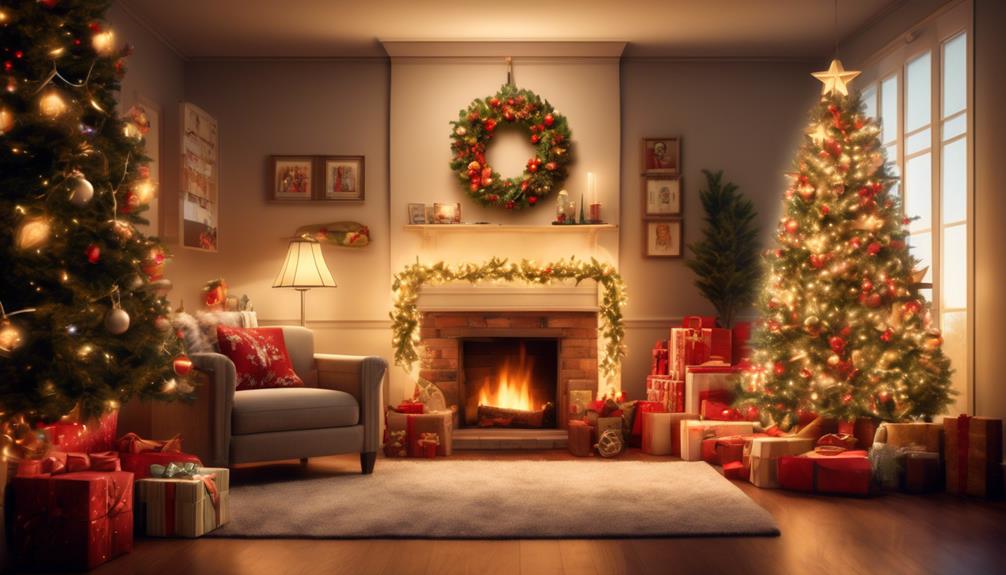
With the careful selection and arrangement of Christmas decorations, a festive atmosphere is created, filling the air with a sense of joy and anticipation. The act of decorating our homes and surroundings during the holiday season goes beyond mere aesthetics; it holds deep psychological benefits and reflects the historical and commercialization effects of Christmas.

Decorations play a pivotal role in setting the mood for Christmas. They evoke a sense of nostalgia and tradition, reminding us of cherished memories and bringing families together. The vibrant colors, twinkling lights, and delightful ornaments create a visual spectacle that captivates both young and old. The table below showcases some popular Christmas decorations throughout history:
| Decoration | Origin |
|---|---|
| Christmas tree | Germany |
| Wreaths | Ancient Rome |
| Holly and Ivy | Pagan rituals |
| Mistletoe | Druids |
| Advent calendars | Germany |
However, it is important to acknowledge the commercialization effects on Christmas decorations. The holiday season has become strongly associated with consumerism, as retailers capitalize on the demand for festive ornaments. While this may detract from the true spirit of Christmas, it also provides an opportunity for individuals to express their creativity and showcase their unique style.
Beyond the commercial aspect, there are psychological benefits to decorating for Christmas. Research suggests that engaging in festive activities, such as decorating, can boost mood, reduce stress, and foster a sense of belonging. The act of embellishing our surroundings with symbols of joy and celebration has a powerful impact on our overall well-being.
Personal Meaning and Connection to Christmas Decorations
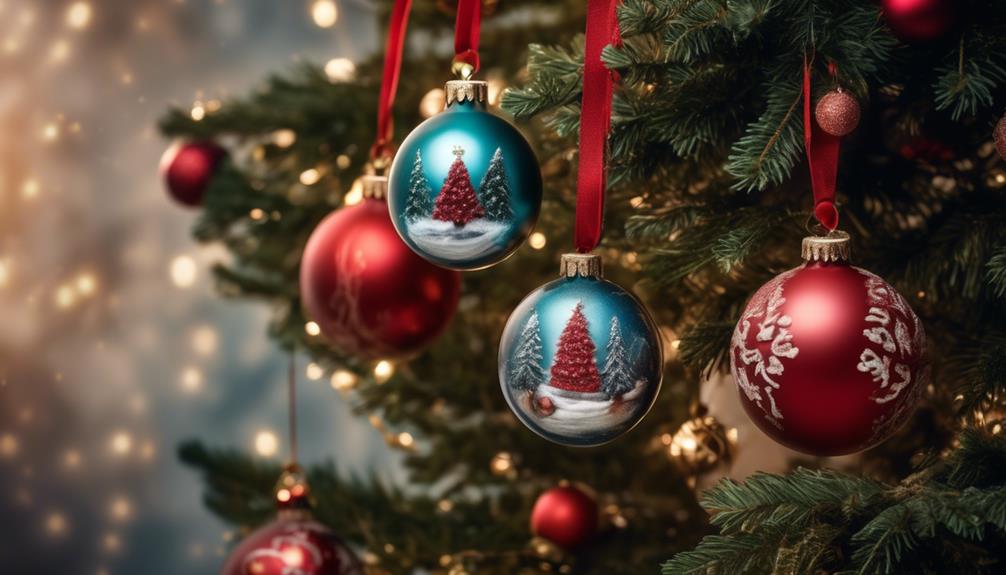
As individuals, our personal connection to Christmas decorations goes beyond their visual appeal. These decorations hold emotional significance, evoking feelings of joy, warmth, and nostalgia.
They become symbols of cherished traditions and memories, creating a sense of continuity and belonging during the holiday season.
Emotional Significance of Decorations
Having been passed down through generations, our Christmas decorations hold personal meaning and evoke a deep emotional connection to the holiday season. These ornaments and adornments go beyond mere decorative items; they serve as symbolic representations of cherished memories and traditions.
Each decoration tells a story, reminding us of the people and moments that have shaped our lives. We attach sentimental value to these objects, as they bring back feelings of joy, warmth, and togetherness. Our collection of decorations serves as a visual narrative of our family's history, with each piece reflecting a specific time and place.
From the handmade ornaments crafted by loved ones to the heirloom decorations that have been in the family for generations, these cherished objects bring a sense of continuity and tradition to our Christmas celebrations.
Tradition and Nostalgia
Our personal connection to Christmas decorations is rooted in the deep sense of tradition and nostalgia they evoke, carrying with them the weight of cherished memories and the stories of generations past. These nostalgic traditions hold a sentimental value that transcends time and brings us back to a simpler, more innocent era.
When we unpack our ornaments and hang them on the tree, we become part of a long-standing lineage, continuing customs that have been passed down through the years. The act of decorating our homes with wreaths, lights, and stockings connects us to our ancestors, reminding us of the joy and love that surrounded them during the holiday season.
As we adorn our living spaces, we're enveloped in a warm embrace of tradition, creating a sense of belonging and comfort that's truly unparalleled.
Frequently Asked Questions
What Are Some Popular Christmas Decorations Throughout History?
Popular Christmas decorations throughout history have evolved to include evergreen wreaths, candles, and nativity scenes. These decorations symbolize the spirit of Christmas and serve as reminders of the holiday's religious and cultural significance.
How Do Christmas Decorations Create a Festive Atmosphere?
Decorations have a significant impact on our mood during Christmas, creating a festive atmosphere. They evoke a sense of joy and excitement, reminding us of the holiday spirit. Additionally, they hold cultural significance, reflecting traditions and customs that have been passed down through generations.
What Is the Personal Meaning and Connection to Christmas Decorations?
Decorations at Christmas hold emotional significance for us. They remind us of nostalgic memories, like the time we gathered around the tree with loved ones. They create a festive atmosphere and bring joy to our hearts.
What Is the Role of Commercialization in Christmas Decorating?
The role of consumerism in Christmas decorating has had a significant impact on the environment. Over time, the emphasis on buying new decorations each year has created excessive waste and contributed to the depletion of natural resources.
What Is the Psychological Impact of Christmas Decorations?
Psychological effects of Christmas decorations include increased feelings of joy and nostalgia. Research shows that decorating can create emotional connections to past memories and promote a sense of belonging and happiness within a community.
Conclusion
In conclusion, the tradition of putting up Christmas decorations holds a rich and diverse history. From its origins rooted in ancient pagan traditions to its religious and cultural significance, Christmas decorations have evolved over time.
They not only create a festive atmosphere but also symbolize the joy and hope associated with the holiday season. Despite the influence of commercialization, the personal meaning and connection to these decorations continue to bring people together in celebration and reflection of the true spirit of Christmas.
- About the Author
- Latest Posts
Introducing Ron, the home decor aficionado at ByRetreat, whose passion for creating beautiful and inviting spaces is at the heart of his work. With his deep knowledge of home decor and his innate sense of style, Ron brings a wealth of expertise and a keen eye for detail to the ByRetreat team.
Ron’s love for home decor goes beyond aesthetics; he understands that our surroundings play a significant role in our overall well-being and productivity. With this in mind, Ron is dedicated to transforming remote workspaces into havens of comfort, functionality, and beauty.

Picture turning your used artificial Christmas tree into a beautiful garden ornament. By using some creativity and expertise, you can spruce up your garden for the holidays while also being environmentally conscious.
In this article, we’ll show you how to recycle artificial Christmas trees to decorate your garden. From selecting the right tree to preparing it for outdoor use, we’ll provide practical tips and creative ideas to help you repurpose your holiday tree and add a touch of magic to your outdoor space.
Key Takeaways
- Choose a tree size and shape that fits well in your garden space.
- Upcycle your artificial tree by adding bird feeders, hanging flower baskets, or string lights.
- Repurpose your tree with imagination and turn it into a unique garden decoration.
- Regularly water live branches and remove any dead or wilted foliage.
Selecting the Right Artificial Christmas Tree for Garden Decor
You should start by choosing the right artificial Christmas tree for your garden decor. An outdoor Christmas tree can be a stunning addition to your garden, adding a touch of festive charm. When selecting your tree, consider the size and shape that will fit best in your garden space.
Look for a tree that’s specifically designed for outdoor use, as it will be more durable and weather-resistant. Additionally, consider the style and color of your garden ornaments to ensure that your tree complements your existing decor.
Whether you prefer a traditional green tree or a more unique color, such as white or silver, there are plenty of options available. By selecting the right artificial Christmas tree, you can create a magical outdoor display that will delight both you and your guests.
Preparing the Artificial Christmas Tree for Outdoor Use
Get your outdoor space ready by making sure your artificial tree is properly prepared for use. Before placing your tree in the garden, consider upcycling options to give it a new purpose. You can transform your artificial tree into a unique garden decoration by adding bird feeders, hanging flower baskets, or even string lights. To ensure its longevity, weatherproofing techniques are essential. Here are some tips to protect your tree from the elements:
| Weatherproofing Techniques | Upcycling Options |
|---|---|
| Apply a waterproof sealant | Bird feeders |
| Use UV-resistant spray paint | Hanging flower baskets |
| Wrap the base with plastic | String lights |
Creative Ideas for Repurposing Artificial Christmas Trees in the Garden
Transforming your artificial tree into a unique garden decoration can add a touch of creativity to your outdoor space. Instead of throwing away your old Christmas tree, consider repurposing it for outdoor crafts and giving it a new life in your garden.
Here are some unique ways to use artificial Christmas trees in the garden:
-
Create a bird feeder: Hang pinecones filled with birdseed from the branches of the tree. The birds will love having a feeding station in your garden.
-
Make a wreath: Use the branches of the artificial tree to create a beautiful wreath for your garden gate or front door. Add some colorful decorations to make it truly unique.
-
Build a garden trellis: Use the sturdy branches of the tree to create a trellis for your climbing plants. It won’t only support their growth but also add a whimsical touch to your garden.
With a little imagination, you can repurpose your artificial Christmas tree and turn it into a one-of-a-kind garden decoration.
Tips for Decorating the Garden With Recycled Artificial Christmas Trees
Spruce up your outdoor space by repurposing your old holiday tree into unique decorations for your garden. Transforming your artificial Christmas tree into DIY outdoor Christmas tree decorations is a fun and eco-friendly way to add a festive touch to your garden all year round. Check out the table below for some creative ideas on how to repurpose your artificial Christmas tree:
| Decoration Idea | Materials Needed | How to Make |
|---|---|---|
| Miniature Tree | Tree branches, pots, decorations | Cut branches to desired length and attach to a small pot. Decorate with ornaments and lights. |
| Garland | Tree branches, wire | Bend wire into desired shape and attach branches. Hang as garland around fences or pergolas. |
| Bird Feeder | Tree branches, birdseed, wire | Attach branches together to form a platform. Fill with birdseed and hang from a tree branch. |
Now that you have some ideas for repurposing your artificial Christmas tree, let’s move on to the next section to learn how to maintain and care for these decorations in your garden.
Maintaining and Caring for Artificial Christmas Tree Decorations in the Garden
To keep your outdoor Christmas tree decorations looking their best, make sure to regularly water any live branches and remove any dead or wilted foliage. Caring for artificial Christmas tree decorations in the garden requires some attention and maintenance. Here are some tips to help you protect and maintain your artificial Christmas trees in the garden:
-
Provide proper support: Use sturdy stakes or a tree stand to secure your artificial tree in the garden, especially in windy conditions.
-
Clean regularly: Dust and debris can accumulate on your artificial tree, so make sure to clean it regularly with a soft brush or cloth to maintain its appearance.
-
Protect from harsh weather: Extreme weather conditions like heavy rain, snow, or strong winds can damage your artificial tree. Consider using a protective cover or moving it to a sheltered area during inclement weather.
Frequently Asked Questions
Can I Use a Real Christmas Tree for Garden Decor Instead of an Artificial One?
You can definitely use a real Christmas tree for garden decor instead of an artificial one. However, there are some benefits to using an artificial tree, such as durability and reusability.
How Do I Determine the Correct Size of Artificial Christmas Tree to Use in My Garden?
To determine the correct size of an artificial Christmas tree for your garden, measure the available space and consider the overall aesthetic you want to achieve. Choose a tree that fits well and complements your garden’s design.
Can I Leave My Artificial Christmas Tree Outside in All Weather Conditions?
You shouldn’t leave your artificial Christmas tree outside in all weather conditions. It’s important to protect it from harsh elements to ensure its longevity. Follow best practices for outdoor decoration to keep it looking great.
Are There Any Safety Precautions I Should Take When Repurposing an Artificial Christmas Tree in the Garden?
When repurposing an artificial Christmas tree in the garden, it’s important to take safety precautions. Follow these repurposing tips to ensure a safe and successful project.
How Often Should I Clean and Maintain My Recycled Artificial Christmas Tree Decorations in the Garden?
You should clean and maintain your recycled artificial Christmas tree decorations in the garden regularly. Dust and debris can accumulate, so a quick wipe-down and inspection every few weeks will keep them looking fresh and festive.
Conclusion
In conclusion, recycling artificial Christmas trees to decorate your garden is a practical and creative way to add a festive touch to your outdoor space. By selecting the right tree, preparing it for outdoor use, and implementing creative ideas for repurposing, you can create a unique garden decor that will impress your guests.
Remember to maintain and care for your artificial tree decorations to ensure they last for many seasons to come. Happy gardening!
- About the Author
- Latest Posts
Introducing Charles, the Editor in Chief at ByRetreat, whose passion for interior design and editorial excellence elevates every remote workspace to new heights. With his keen eye for detail, impeccable taste, and expertise in design, Charles brings a wealth of knowledge and creativity to the ByRetreat team.
As the Editor in Chief of a renowned lifestyle blog, Charles has honed his skills in curating captivating content and staying up-to-date with the latest trends in interior design. His deep understanding of aesthetics and the power of storytelling through design enables him to create remote workspaces that are not only visually stunning but also rich in personality and meaning.
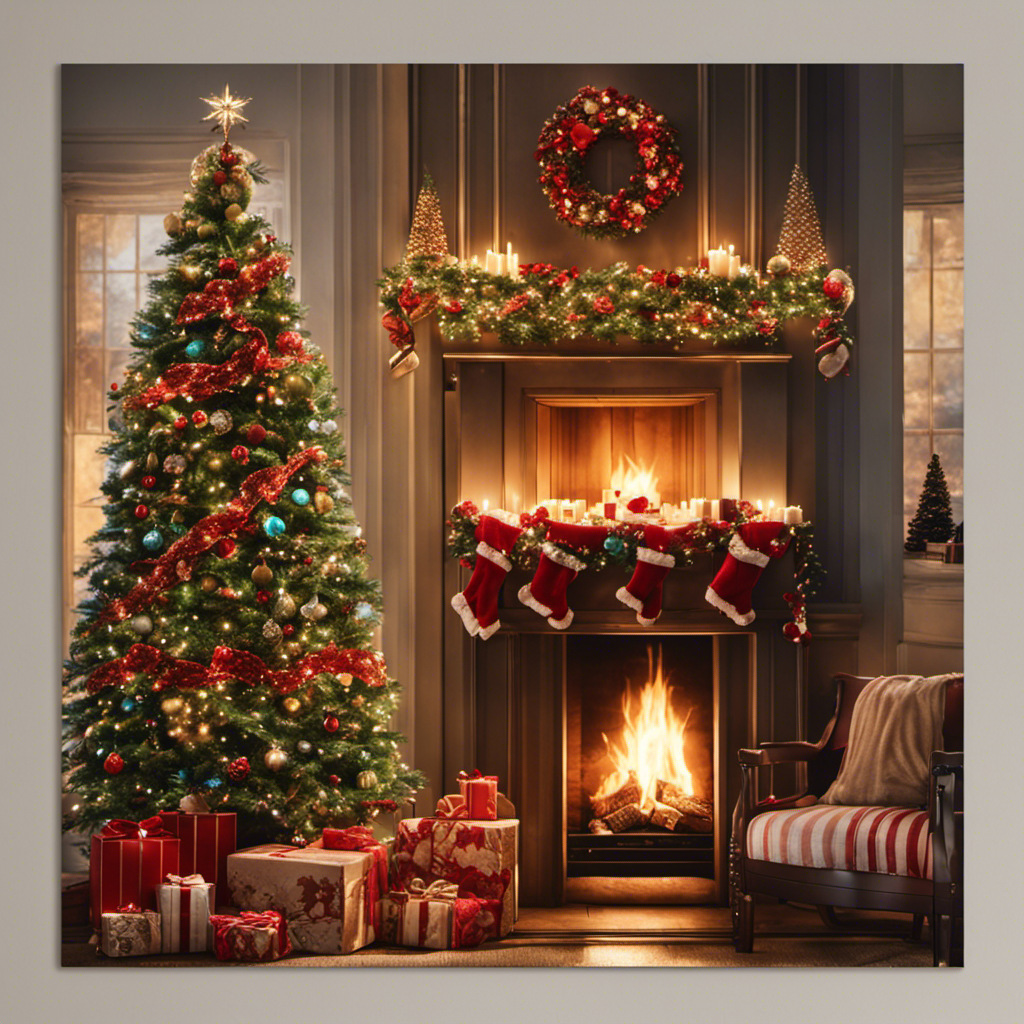
Have you ever thought about when is the right time to remove your Christmas decorations?
In the British tradition, there is a specific date that marks the end of the festive season. Known as Twelfth Night, it falls on January 5th, twelve days after Christmas Day.
This longstanding practice has its historical origins and regional variations across the UK. Understanding the significance of this tradition and its modern interpretation can add a touch of sophistication to your holiday celebrations.
Key Takeaways
- The tradition of taking down Christmas decorations originated in the Victorian era and was believed to bring bad luck if decorations were left up past Twelfth Night.
- Twelfth Night, celebrated on January 6th, marks the end of the Christmas season and symbolizes the visit of the three wise men to baby Jesus.
- The traditional date for taking down decorations is January 6th, but there are regional variations in the UK, with Scotland, Northern Ireland, and Wales having their own customs.
- Modern interpretation of the tradition allows for more flexibility, with some people choosing to take down decorations earlier or keep them up longer to extend the festive atmosphere.
Historical Origins of the Tradition
You might be wondering where the tradition of taking down Christmas decor originated. Well, let’s delve into its historical significance and cultural customs.
The tradition of removing Christmas decorations dates back to the Victorian era in Britain. During this time, Christmas trees were adorned with candles, ribbons, and ornaments, creating a festive atmosphere. However, it was believed that leaving the decorations up past Twelfth Night, which falls on January 5th or 6th, would bring bad luck for the coming year.
Twelfth Night is the traditional end of the Christmas season and marks the arrival of the Feast of the Epiphany. It symbolizes the visit of the three wise men to baby Jesus. Therefore, taking down the decorations before or on Twelfth Night became a customary practice in British culture.
Significance of the Twelfth Night
Celebrate the significance of the Twelfth Night by keeping your holiday decorations up until January 6th. This traditional date marks the end of the Christmas season and is rich in customs and superstitions. Here are three ways to embrace this festive occasion:
-
Wassailing: Gather with friends and family to go door-to-door, singing carols and sharing a warm drink to bless the orchards for a fruitful year ahead.
-
Twelfth Night Cake: Bake a delicious cake with a hidden bean and a pea. The person who finds the bean becomes the king or queen for the night, while the one who discovers the pea must be their servant.
-
Taking down decorations: On Twelfth Night, it’s believed that leaving Christmas decorations up beyond this date brings bad luck. So, bid farewell to the holiday season and prepare for the year ahead by carefully packing away your festive adornments.
As the Twelfth Night festivities come to an end, it’s time to explore the traditional date for taking down decorations.
Traditional Date for Taking Down Decorations
Bid farewell to the holiday season by adhering to the traditional date of January 6th for removing your festive adornments. This date, known as Twelfth Night, has been celebrated for centuries and holds cultural significance in many countries. The belief is that leaving decorations up beyond this date brings bad luck or hinders the arrival of spring.
While some may view this practice as superstitious, it’s an interesting cultural tradition that has stood the test of time.
In addition to cultural beliefs, there’s also an environmental impact to consider when it comes to keeping decorations up for longer periods. Many Christmas decorations are made from non-biodegradable materials, such as plastic and synthetic fibers, which can contribute to pollution and waste.
By adhering to the traditional date, you can minimize the environmental impact and ensure a more sustainable approach to celebrating the holiday season.
Regional Variations in the UK
In the UK, different regions have their own unique customs and practices when it comes to removing holiday decorations. Regional customs often reflect cultural differences and add a touch of diversity to this tradition. Here are three examples of regional variations in the UK:
-
In Scotland, it’s common to take down Christmas decorations on or before January 5th, which is known as ‘Twelfth Night.’ This date marks the end of the Christmas season and the arrival of Epiphany.
-
In Northern Ireland, some households adhere to the tradition of taking down decorations on January 6th, which is also known as ‘Little Christmas’ or ‘Women’s Christmas.’ This day is dedicated to women and is seen as the final opportunity to celebrate the festive season.
-
In Wales, it’s customary to remove decorations on January 7th, known as ‘Festival of Fools.’ This date is associated with a humorous celebration where people play pranks on each other.
These regional customs highlight the rich cultural tapestry of the UK and demonstrate how different communities interpret and celebrate the end of the Christmas season.
Now, let’s delve into the modern interpretation of this tradition.
Modern Interpretation of the Tradition
To put a unique spin on the end of the holiday season, you can embrace a modern interpretation of removing your festive decorations.
Traditionally, the British have followed the custom of taking down Christmas decorations on the twelfth night after Christmas, which falls on January 5th or 6th. However, in recent times, there’s been a shift in cultural significance and more flexibility in interpreting this tradition.
Some people now choose to take down their decorations earlier, either out of convenience or personal preference. Others may choose to keep them up longer, extending the festive atmosphere into the new year.
This modern interpretation allows individuals to personalize the end of the holiday season and reflect their own values and desires, adding a touch of individuality to an age-old tradition.
Frequently Asked Questions
What Are Some Common Types of Christmas Decorations Used in the Uk?
In the UK, people use different types of Christmas decorations. Traditional decorations, like Christmas trees and ornaments, are popular. Some prefer homemade decorations, while others opt for store-bought ones. Christmas lights and fairy lights are also commonly used.
How Do Other Countries Celebrate the End of the Christmas Season?
Different countries have their own unique ways of celebrating the conclusion of the Christmas season. From Spain’s Three Kings Day to Russia’s Old New Year, these end of season festivities showcase cultural diversity and traditions.
Are There Any Specific Rituals or Ceremonies Associated With Taking Down Christmas Decorations in the Uk?
In the UK, taking down Christmas decorations involves various rituals and ceremonies. These practices carry cultural significance and have historical origins. Some alternative traditions have also emerged over time.
Has the Tradition of Taking Down Christmas Decorations on the Twelfth Night Always Been Practiced in the Uk?
The tradition of taking down Christmas decorations on the twelfth night has not always been practiced in the UK. Its historical origins can be traced back to ancient times. However, attitudes towards this tradition have changed in modern-day UK.
Are There Any Superstitions or Beliefs Associated With Leaving Christmas Decorations up Past the Traditional Date for Taking Them Down?
Leaving up Christmas decorations past the traditional date can be seen as bad luck or a sign of laziness. It is important to respect the cultural significance of taking them down on time to avoid any negative superstitions.
Conclusion
So, you’ve finally reached the end of the festive season, and it’s time to bid farewell to your beloved Christmas decorations.
According to tradition, you should wait until the Twelfth Night to take them down. But let’s be honest, who’s got the time or patience for that?
In this modern age, we don’t need to stick to ancient customs. So go ahead, break the tradition, and take down those decorations whenever you please.
After all, rules were made to be broken, right?
- About the Author
- Latest Posts
Introducing Ron, the home decor aficionado at ByRetreat, whose passion for creating beautiful and inviting spaces is at the heart of his work. With his deep knowledge of home decor and his innate sense of style, Ron brings a wealth of expertise and a keen eye for detail to the ByRetreat team.
Ron’s love for home decor goes beyond aesthetics; he understands that our surroundings play a significant role in our overall well-being and productivity. With this in mind, Ron is dedicated to transforming remote workspaces into havens of comfort, functionality, and beauty.
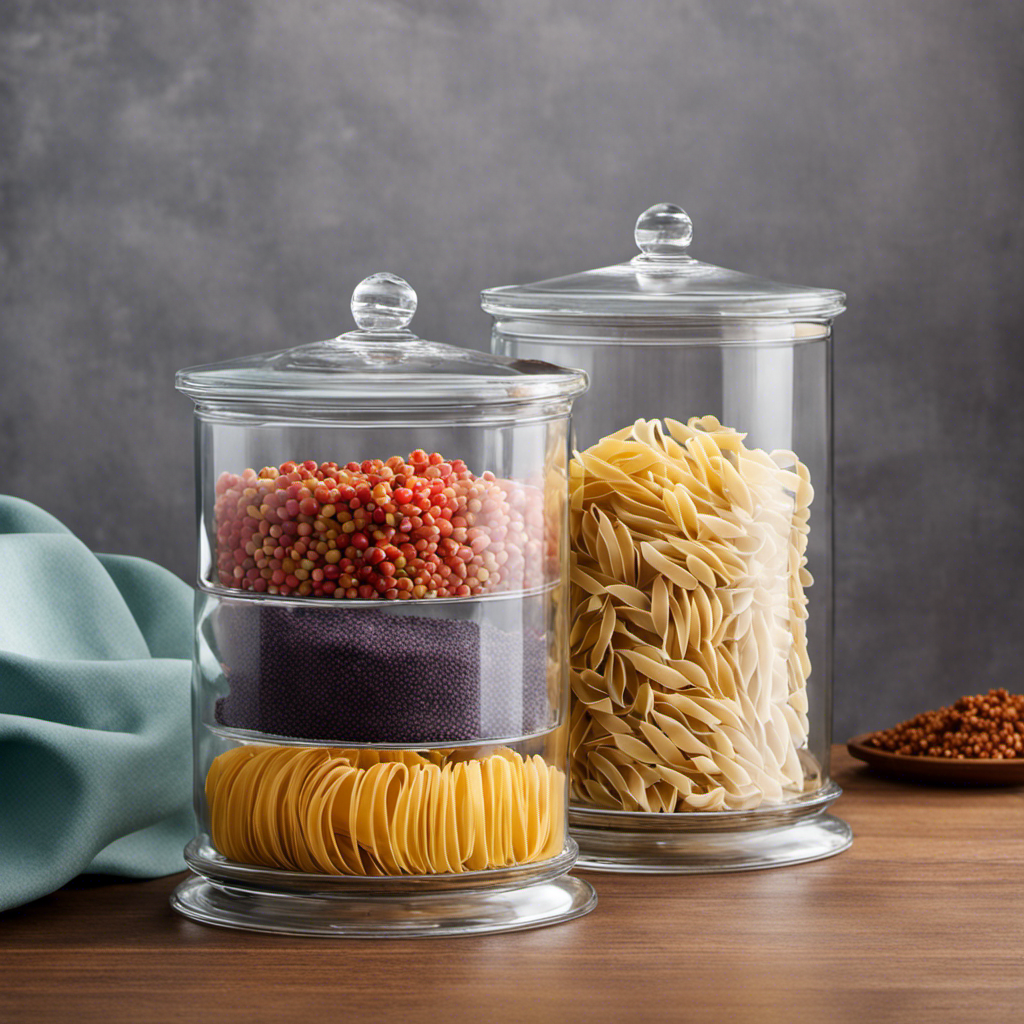
Hey everyone! Have you ever faced difficulties in enhancing your kitchen decor? Don’t worry, because I have some great ideas on what to put in those clear canisters. Believe me, it will make a big difference.
From fresh herbs and spices to colorful dry pasta, and even assorted baking supplies, the options are endless.
Oh, and let’s not forget about dried fruits and nuts, or the heavenly aroma of coffee beans and tea leaves.
Get ready to transform your kitchen into a stylish and functional space!
Key Takeaways
- Fresh herbs and spices bring freshness and vitality to the kitchen
- Colorful dry pasta adds pop of color and personality to the kitchen
- Organized baking supplies save time and add elegance to the kitchen
- Coffee beans and tea leaves in clear canisters add elegance and aroma to the kitchen
Fresh Herbs and Spices
I love filling clear canisters with fresh herbs and spices to add a burst of flavor and color to my kitchen decor.
One of my favorite ways to incorporate herbs into my kitchen is by creating an indoor herb garden. It not only adds a touch of greenery but also provides me with a convenient source of fresh herbs for cooking.
I enjoy the process of selecting different herbs like basil, rosemary, and thyme, and nurturing them as they grow. Not only do they enhance the aroma and taste of my dishes, but they also bring a sense of freshness and vitality to my kitchen.
Additionally, I enjoy experimenting with DIY spice blends. By combining different spices like cumin, paprika, and garlic powder, I can create unique flavors that perfectly complement my culinary creations. Having these spice blends readily available in clear canisters not only adds a decorative touch to my kitchen but also makes it easy for me to access and use them while cooking.
Colorful Dry Pasta
My favorite way to spruce up my kitchen is by using colorful dry pasta as a vibrant and eye-catching decorative element in my home. Not only does it add a pop of color, but it also brings a touch of whimsy and personality to my kitchen decor.
Here are some ideas to inspire you:
-
Different Shaped Pasta: From bowties to spirals, there are so many unique and interesting pasta shapes available. Mix and match them to create a visually appealing display in your clear canisters.
-
Vintage Kitchen Utensils: Pair your colorful dry pasta with vintage kitchen utensils to create a charming and nostalgic vibe. Hang old whisks, spatulas, and ladles on the wall or display them in a jar alongside the pasta.
-
Layered Pasta: Create layers of different colored pasta in your canisters for a stunning visual effect. This is a simple yet effective way to add depth and dimension to your kitchen decor.
Assorted Baking Supplies
One way to organize my assorted baking supplies is by using labeled containers to easily identify and access the ingredients and tools I need.
For my decorative sprinkles, I’ve a clear glass jar that showcases the vibrant colors and textures. It adds a pop of excitement to my kitchen decor, while also keeping my sprinkles fresh and easily accessible.
Another container I use is a small plastic bin for my cookie cutters. I label it ‘Cookie Cutters’ and place it on a shelf within reach. This way, whenever I’m in the mood for baking cookies, I can quickly find the perfect shape without rummaging through drawers.
Organizing my baking supplies in this way not only saves me time but also adds a touch of elegance to my kitchen.
Dried Fruits and Nuts
To keep my dried fruits and nuts fresh, I store them in airtight containers. Not only do dried fruits and nuts add a burst of flavor and texture to any dish, but they also come with numerous health benefits.
Here are some reasons why you should incorporate them into your diet:
- Boost of nutrients: Dried fruits and nuts are packed with essential vitamins, minerals, and antioxidants that promote overall well-being.
- Energy-packed snacks: Whether you’re on-the-go or need a pick-me-up during the day, dried fruits and nuts provide a quick and nutritious energy boost.
- Versatile ingredients: Get creative in the kitchen by using dried fruits and nuts in a variety of recipes, from salads and baked goods to savory dishes like stir-fries and pilafs.
Coffee Beans and Tea Leaves
I love the aroma of freshly ground coffee beans and the soothing taste of steeped tea leaves. There’s something magical about starting the day with a cup of freshly brewed coffee or a fragrant cup of tea.
When it comes to kitchen decor, clear canisters filled with coffee beans and loose leaf tea are a perfect choice. Not only do they add a touch of elegance to the kitchen, but they also serve a practical purpose. The rich, earthy scent of coffee beans fills the air, creating a warm and inviting atmosphere.
The canisters can be arranged on a countertop or displayed on a shelf, allowing you to showcase your favorite blends. To enhance the visual appeal, you can also add a few sprigs of aromatic herbs like lavender or mint to the canisters. This not only adds a pop of color but also infuses a subtle herbal fragrance into the air.
Frequently Asked Questions
How Can I Properly Store Fresh Herbs and Spices to Maintain Their Freshness and Flavor?
To properly store herbs and spices for freshness, I recommend using clear canisters. This allows you to easily see and access your collection. Ensure they are tightly sealed to maintain flavor and store in a cool, dry place away from sunlight.
What Are Some Creative Ways to Display Colorful Dry Pasta in Clear Canisters?
I love finding creative ways to display colorful dry pasta in clear canisters. It’s a great way to add a pop of color to my kitchen decor. I also enjoy showcasing fresh flowers and colorful candy for a fun and vibrant look.
How Should I Organize and Store Assorted Baking Supplies in Clear Canisters for Easy Access?
I love using clear canisters to organize and store my assorted baking supplies. It’s a great way to keep everything easily accessible. I also have some ideas for organizing small kitchen appliances and tips for storing bulk grains and flours.
Can I Store Dried Fruits and Nuts Together in the Same Clear Canister or Should They Be Stored Separately?
Storing dried fruits and nuts together in a clear canister can be convenient, but it may affect their flavors and textures. Separating them ensures freshness and prevents cross-contamination.
What Are Some Tips for Selecting and Storing Coffee Beans and Tea Leaves in Clear Canisters to Preserve Their Flavor and Aroma?
When it comes to selecting canister sizes for coffee beans and tea leaves, it’s important to consider the quantity you typically use. To preserve their flavor and aroma, clean and maintain clear canisters regularly.
Can Clear Canisters Be Used to Display Christmas Decorations in the Kitchen?
Yes, clear canisters can beautifully showcase Christmas decorations for kitchen. Fill them with festive items like colorful cookie cutters, candy canes, mini ornaments, or cinnamon sticks. The transparent containers allow you to create a visually appealing holiday display while keeping your kitchen organized and festive.
Conclusion
In conclusion, filling clear canisters with various ingredients not only adds a decorative touch to your kitchen but also serves a practical purpose.
From fragrant herbs and spices to vibrant pasta and versatile baking supplies, the options are endless.
Don’t forget to include dried fruits and nuts for a healthy snack option, and coffee beans or tea leaves for a delightful caffeine fix.
Remember, the world is your oyster when it comes to kitchen decor, so let your creativity run wild!
- About the Author
- Latest Posts
Meet Bethia, the visionary designer at ByRetreat who brings a touch of magic to every remote workspace she creates. With a boundless imagination and an eye for beauty, Bethia is passionate about transforming ordinary spaces into extraordinary havens of creativity and comfort.
Bethia possesses a unique talent for envisioning the perfect combination of furniture, colors, and textures that harmonize seamlessly in a room. She understands that selecting furniture goes beyond mere functionality; it’s about curating pieces that evoke a sense of style and sophistication while enhancing the overall ambiance.
-

 Decor2 weeks ago
Decor2 weeks agoMaximalist Decor Explained: Embrace More Style
-

 Vetted3 weeks ago
Vetted3 weeks ago15 Best Foot Massagers for Neuropathy to Soothe Your Feet and Relieve Discomfort
-

 Vetted4 weeks ago
Vetted4 weeks ago15 Best Sports Laundry Detergents for Keeping Your Activewear Fresh and Clean
-

 Vetted4 weeks ago
Vetted4 weeks ago15 Best Tall Toilets for Seniors That Combine Comfort and Safety
-

 Vetted6 days ago
Vetted6 days ago15 Best Cleaners for Fiberglass Showers to Keep Your Bathroom Sparkling Clean
-

 Vetted2 weeks ago
Vetted2 weeks ago15 Best Organic Pest Control Solutions for a Naturally Pest-Free Home
-
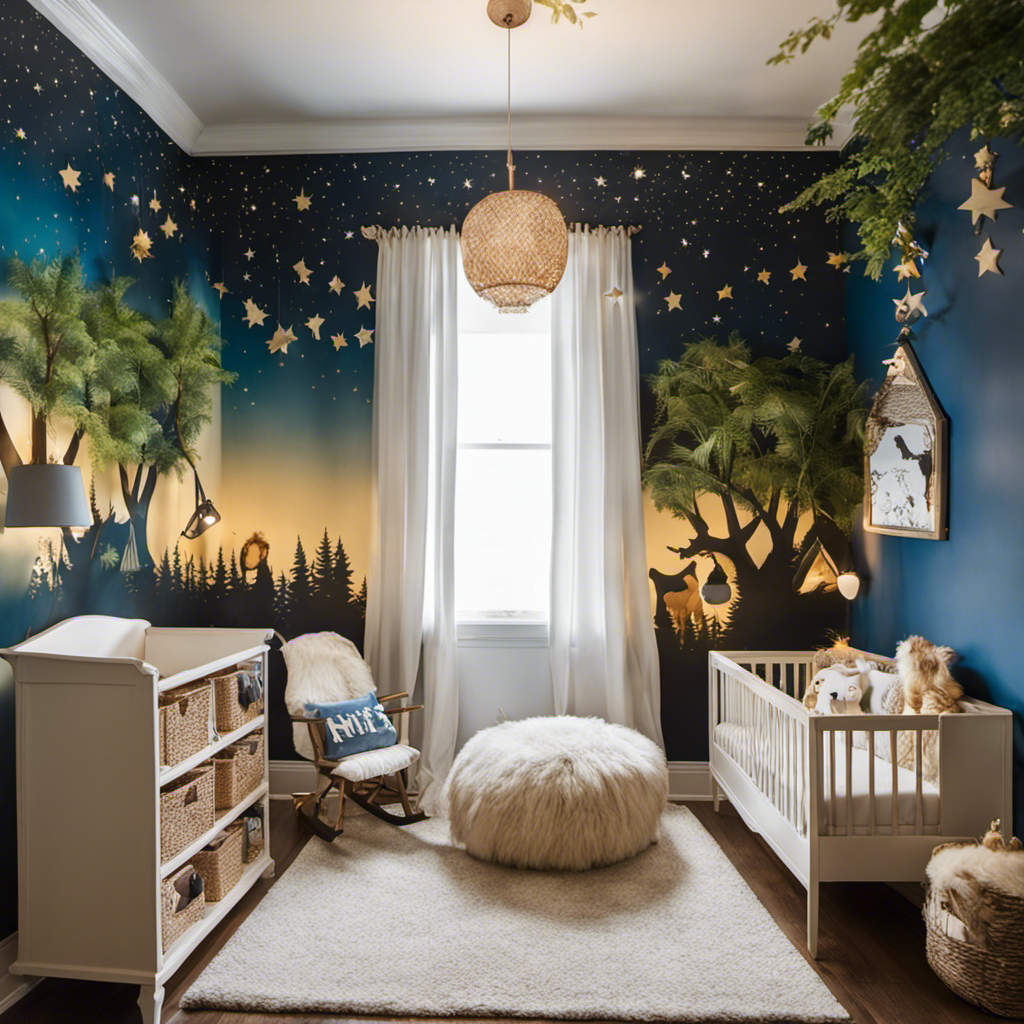
 Decor3 weeks ago
Decor3 weeks agoWhere the Wild Things Are Nursery Decor
-

 Architecture Home Styles4 weeks ago
Architecture Home Styles4 weeks agoExploring the Difference Between Traditional and Contemporary Styles


























